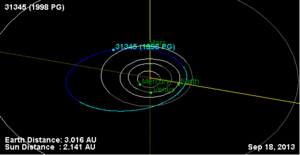(31345) 1998 PG
 | |
| Discovery | |
|---|---|
| Discovered by | LONEOS |
| Discovery date | 3 August 1998 |
| Orbital characteristics[1] | |
| Epoch 13 January 2016 (JD 2457400.5) | |
| Uncertainty parameter 0 | |
| Observation arc | 13601 days (37.24 yr) |
| Aphelion | 2.8041 AU (419.49 Gm) |
| Perihelion | 1.2264 AU (183.47 Gm) |
| 2.0153 AU (301.48 Gm) | |
| Eccentricity | 0.39143 |
| 2.86 yr (1045.0 d) | |
| 8.9514° | |
| 0° 20m 40.236s / day | |
| Inclination | 6.4937° |
| 222.79° | |
| 155.93° | |
| Known satellites | 1 |
| Earth MOID | 0.232976 AU (34.8527 Gm) |
| Jupiter MOID | 2.66484 AU (398.654 Gm) |
| Proper orbital elements | |
Proper mean motion | 125.7425 deg / yr |
Proper orbital period |
2.86299 yr (1045.708 d) |
| Physical characteristics | |
| Dimensions | 900 m (3,000 ft)[2] |
| 2.51620 h (0.104842 d)[1][3] | |
| 0.16[2] | |
| Temperature | 188 K (-85°C) |
| Q | |
| 17.3[1][2] | |
|
| |
(31345) 1998 PG is an Amor near-Earth asteroid discovered by the LONEOS program on August 3, 1998. It is known to have a moon, S/2001 (31345) 1.[4]
Status as a Near-Earth Object
1998 PG is classified as an Amor asteroid. It has made multiple close approaches to Earth, with the closest being 35,648,680 kilometres (22,151,060 mi) on 15 October 1978.[1]
Moon


1998 PG has a single moon, S/2001 (31345) 1. The moon was discovered at the Table Mountain Observatory by analyzing observations from 29 August to 25 October 1998. S/2001 (31345) 1 has a size of 300 metres (980 ft), one-third the size of the asteroid itself, and orbits every 14 hours with a semi-major axis of 1.5 kilometres (0.93 mi).[2] From the surface of 1998 PG, the moon would have an angular diameter of about 16.3°.[lower-alpha 1] For comparison, the Sun appears to be 0.5° from Earth.
Notes
- ↑ Calculated by solving .
References
- 1 2 3 4 "(31345) 1998 PG orbit diagram". JPL Small-Body Database. Jet Propulsion Laboratory. SPK-ID: 2031345. Retrieved 5 April 2016.
- 1 2 3 4 Johnston, W. R. (1 September 2005). "(31345) 1998 PG". Johnston's Archive. Retrieved 2013-09-20.
- ↑ Pravec, P.; et al. (2000). "Two-Period Lightcurves of 1996 FG3, 1998 PG, and (5407) 1992 AX: One Probable and Two Possible Binary Asteroids". Icarus. 146 (1): 190–200. Bibcode:2000Icar..146..190P. doi:10.1006/icar.2000.6375.
- ↑ Lance, B. (6 August 2013). "Binary and Ternary Near-Earth Asteroids Detected by Radar". JPL/NASA. Retrieved 2013-09-20.
Further reading
- Kiss, L. L.; Szabó, Gy.; Sárneczky, K. (1999). "CCD photometry and new models of 5 minor planets". Astronomy and Astrophysics Supplement Series. 140: 21–28. arXiv:astro-ph/9909159
 . Bibcode:1999A&AS..140...21K. doi:10.1051/aas:1999115.
. Bibcode:1999A&AS..140...21K. doi:10.1051/aas:1999115.